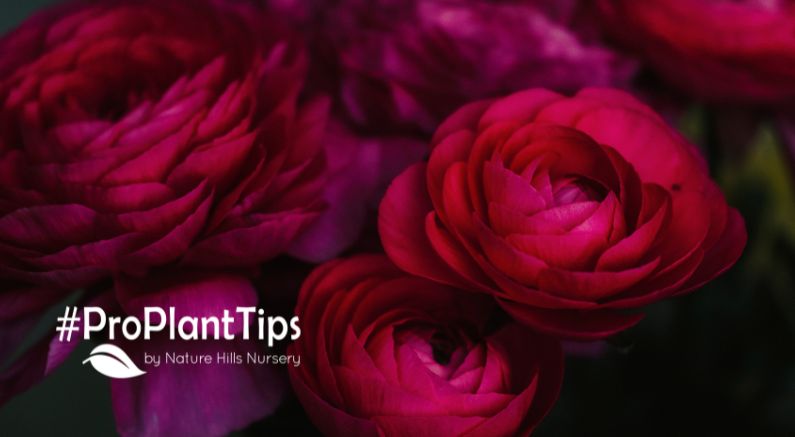Ranunculus, with its vibrant, incredibly full, rose-like blooms and delicate, concentric layers of petals, is a favorite among gardeners and flower enthusiasts alike. These exquisite flowers not only bring color and elegance to your garden but also carry a rich history and symbolism that adds depth to their beauty!
In this guide, we'll explore everything you need to know about Ranunculus, including how to plant and care for these romantic blossoms!
All About Ranunculus

Ranunculus, commonly known as buttercups, are members of the Ranunculaceae family. Native to regions of Asia, Europe, and North Africa, these flowers have been cherished for centuries. The genus name "Ranunculus" is derived from the Latin word "ranunculus", meaning "little frog", as many species thrive in moist environments where frogs are also found.
First cultivated by Persian and Turkish gardeners, Ranunculus was later introduced to Europe during the 16th century. Over time, selective breeding led to the creation of the Ranunculus asiaticus hybrids we know today, prized for their vivid hues and full, multi-petaled blooms.
In the language of flowers, Ranunculus symbolizes charm and attractiveness. Giving someone a cut flower bouquet of Ranunculus conveys the message, "You are radiant with charm!" according to the Victorian language of flowers.
Planting Ranunculus: Step-by-Step Guide
Choosing the Right Location
- Sunlight: Ranunculus thrives in full sun. Choose a location that receives at least 6–8 hours of direct sunlight daily. Hotter growing zones appreciate afternoon shade.
- Soil: Fertile, well-draining soil that is essential. Amend clay-heavy soils with sand or compost to improve drainage.
Planting the Corms
- When to Plant: In zones 8–10, plant corms in the fall for spring blooms. In colder climates (zones 4–7), plant them in late winter or early spring after the risk of frost has passed.
- Pre-Soaking: Before planting, soak the corms in lukewarm water for 3–4 hours to rehydrate them. This helps them establish quickly.
- Planting Depth and Spacing: Plant corms with the "claw" side down, about 2 inches deep and 4–6 inches apart.
- Watering: Water thoroughly after planting to help settle the soil.
Growing Ranunculus Plants
Watering

Keep the soil consistently moist but not waterlogged. Overwatering can lead to root rot, while insufficient watering may hinder growth and flowering.
Fertilizing
Apply a balanced, slow-release fertilizer (10-10-10) at planting time and again during the growing season to promote healthy blooms.
Pest and Disease Management
Watch out for pests such as aphids and spider mites. Use insecticidal soap or neem oil to manage infestations. To prevent fungal diseases, ensure good air circulation and avoid overhead watering.
Deadheading
Regularly remove spent blooms to encourage continued flowering and maintain the plant's appearance.
Lifting Ranunculus Corms in the Fall
In regions with cold winters (zones 3–7), Ranunculus corms must be lifted and stored to protect them from freezing temperatures. Here's how:
- Wait for the Right Time: Once the foliage has yellowed and died back naturally, it's time to lift the corms.
- Dig Carefully: Use a garden fork or trowel to loosen the soil around the plants gently. Avoid damaging the corms.
- Clean and Dry: Shake off excess soil and allow the corms to dry in a warm, airy location for a few days.
- Store Properly: Place the corms in a paper bag or box filled with dry peat moss or vermiculite. Store them in a cool, dark, and dry location (40°F–50°F) until spring.
Forcing Ranunculus Indoors For The Winter
Forcing Ranunculus corms in winter transforms any indoor space into a vibrant, early spring oasis. Planted in decorative pots or shallow trays, their lush green foliage adds texture while the long, elegant stems make them perfect for cut arrangements.
With just the right balance of cool temperatures and bright light, these forced blooms bring warmth, cheer, and a touch of garden magic to the coldest months of the year.
Ranunculus can also be forced indoors to enjoy their beauty during the off-season. Here's how:
- Prepare the Corms: Soak the corms in water for 3–4 hours.
- Choose a Container: Select a pot with good drainage holes and fill it with well-draining potting soil.
- Planting: Plant the corms 2 inches deep and 4 inches apart. Position the pot in a bright, sunny location.
- Watering and Care: Water thoroughly after planting and keep the soil consistently moist. Rotate the pot regularly for even growth.
- Temperature: Maintain a temperature of 50°F – 65°F for optimal growth.
With proper care, you can enjoy vibrant Ranunculus blooms indoors within 12–16 weeks.
Start Enjoying Ranunculus Today!
Ranunculus flowers are more than just a feast for the eyes - they carry a rich history, a meaningful message, and the promise of joy for any gardener! Whether planted in your garden or grown indoors for a burst of winter color, these stunning blooms are worth the effort!
By following the steps outlined in this guide, you will be on your way to enjoying radiant Ranunculus flowers every summer!
Happy Planting!


